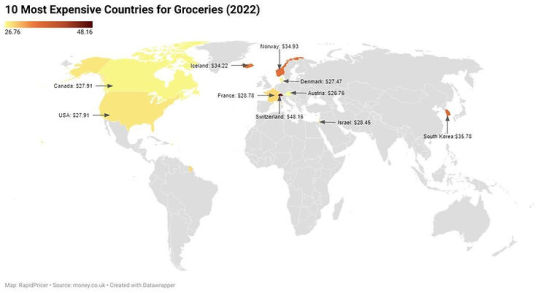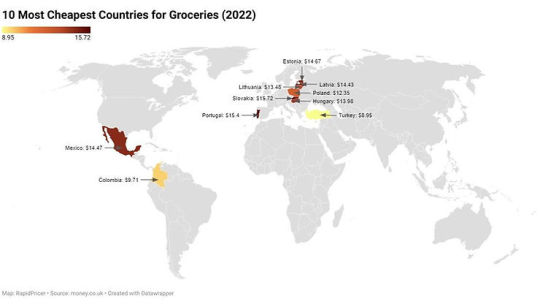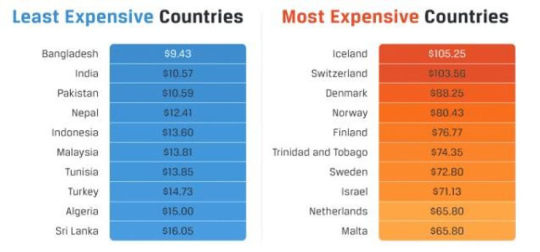#marketcompetitiveness hashtag
Explore tagged Tumblr posts
Text
Unveiling Global Price Differences for Grocery Retailing

Written By: Gargi Sarma
In today's worldwide market, pricing comparisons between nations are crucial for retailers as well as customers. Retailers may strategically place their items in different areas and optimize their pricing strategies to maximize profitability and remain competitive by having a thorough awareness of price discrepancies. However, consumers who compare costs across borders are better able to make informed judgments about what to buy and receive the most value for their money, whether they choose to shop locally or look into foreign options.

Figure 1: Overview of Groceries Index across Countries (2024)
To give businesses and consumers alike a thorough grasp of worldwide price discrepancies, this article seeks to offer insightful information about the importance of comparing costs across national borders. The topic for retailers will examine how to use market insights to optimize pricing strategies and boost competitiveness, delving into the strategic implications of price differentials.
Understanding Price Disparities:
Retailers must comprehend national pricing differences to manage their operations and pricing strategies in foreign markets. These differences are the result of several factors, each of which has a distinct impact on the retail environment:
Currency Exchange Rates: Changes in exchange rates affect retail prices and import expenses. To reduce currency-related risks, retailers need to make frequent price adjustments.
Tariffs and Taxes: International retail prices are impacted by both government taxes and tariffs. Retailers who want to maintain competitive pricing must be aware of and abide by local tax legislation.
Living Expenses: Differences in living expenses have an impact on retail prices and purchasing power. Retailers modify their pricing tactics to take local cost of living considerations into account.
Supply Chain Dynamics: Retail pricing is impacted by the complexity and efficiency of the supply chain. Retailers streamline their supply networks to cut expenses and guarantee on-time delivery.
Regulatory Disparities: Differences in regulations impact retail pricing and raise the cost of compliance. When entering new areas, retailers must manage the complexities of regulations.
The Impact of Globalization: Through convergence and divergence, globalization affects retail prices. Retailers modify their tactics to take advantage of economies of scale and serve a variety of markets.
Methodology for Comparing Prices:
Several approaches are employed when comparing pricing between nations to guarantee accurate and insightful comparisons. Gaining dependable insights into price differences requires a grasp of the strengths and limits of each methodology. Below is an explanation of the various pricing comparison methodologies:
Parity of Purchasing Power (PPP): By comparing the costs of goods and services across countries and adjusting exchange rates to equalize prices when stated in a common currency like the US dollar, PPP theory analyzes monetary values.
Price Index (e.g., Consumer Price Index): Indices such as the CPI monitor variations in the average price of a basket of goods and services over time, indicating trends in either deflation or inflation as well as shifts in the purchasing power of a country.
The Basket of Goods Method: This method provides information on relative affordability and market competitiveness by comparing the costs of a chosen set of goods and services across international borders. Retailers frequently use it to evaluate pricing tactics and make comparisons with rival businesses.
Case Studies and Examples:
Comparison of Prices for Selected Goods and Services Across Different Countries:
Food and Groceries

Figure 2: 10 Most Expensive Countries For Groceries (2022)

Figure 3: 10 Most Cheapest Countries For Groceries (2022)
USA: Brand, store type and location are some of the variables that affect food prices in the USA. When compared to other industrialized nations, the average cost of groceries in the USA is reasonable.
India: Because of its big agricultural sector and cheaper production costs, India typically has lower food prices than other nations. Prices, however, might differ greatly between rural and urban locations.
Mexico: A lot of reasonably priced food options are available in Mexico, especially for locally manufactured goods. Costs may be comparatively lower in Mexico than in other nations, which draws travellers on a tight budget.
Netherlands: Due to factors including high labor expenses, stringent regulations, and import tariffs, food prices in the Netherlands are often higher than in several other European countries. But there are other reasonably priced solutions out there, particularly in supermarkets.
Switzerland: The country is renowned for having a high cost of living, which includes comparatively high food prices. Switzerland has higher grocery costs due to several factors, including a small amount of arable land, hefty import taxes, and a strong currency.
Dubai: The cost of food varies in Dubai based on several variables, including store type, location, and the proportion of domestically and imported goods. Due to import duties, some products may be pricey, but others—especially locally-grown produce—may be reasonably priced.
Singapore: Land scarcity, high labor costs, and reliance on imports are some of the factors influencing Singapore's food prices. Although meal costs in Singapore are often higher than in its neighbors, there are some reasonably priced options, especially at hawker centers.
Australia: Due to reasons including geographic remoteness, high labor expenses, and stringent restrictions, food prices in Australia might be relatively high when compared to some other countries. But there are other reasonably priced solutions out there, particularly in local markets and supermarkets.

Figure 4: Price Level By Country
Healthcare services
USA: The United States of America has some of the highest healthcare expenditures in the world, primarily due to high administrative costs, costly medical procedures, and pharmaceutical pricing.
India: Compared to wealthy nations, healthcare services in India are typically more economical, with lower consultation, hospital, and prescription prices. India has a high rate of medical tourism because of its affordable healthcare alternatives.
Mexico: In comparison to the United States, Mexico provides reasonably priced healthcare services, with lower consultation fees, hospitalization charges, and drug pricing. Mexico is seeing an increase in medical tourism as well, especially for elective treatments.
Netherlands: With a sophisticated healthcare system and universal health coverage, healthcare prices in the Netherlands are reasonable when compared to those in several other European nations. Nonetheless, the cost of private healthcare services can often be high.
Switzerland: Due to variables including pricey medical equipment, high-quality healthcare infrastructure, and high salaries for medical professionals, Switzerland has some of the highest healthcare expenditures in the world.
Dubai: Depending on a number of variables, including the facility type, medical expertise, and insurance coverage, the cost of healthcare services in Dubai varies greatly. In comparison to Western nations, certain services might be more reasonably priced, while others might be more costly.
Singapore: In comparison to Western nations, Singapore provides excellent healthcare services at reasonably affordable prices. Residents can afford healthcare more easily because of government insurance programs and healthcare subsidies.
Australia: With a combination of public and private healthcare choices, healthcare prices in Australia are low when compared to some other wealthy nations. The government's Medicare program lowers individuals' out-of-pocket costs by offering subsidies for necessary medical services.
Regional Variances and Trends:
With an emphasis on retail pricing, the following examines regional price disparities and new developments in worldwide price patterns:


Figure 6: Average Cost of Meal For Two in 2020 (Source: Numbeo.com)
Asia-Pacific: Because of the region's varied economic development levels, disparities in infrastructure, and import/export expenses, there are notable pricing fluctuations in this area. For comparable commodities, industrialized economies like South Korea and Japan typically charge more than developing economies like Vietnam and India.
Europe: Because of economic unity brought forth by the European Union, price fluctuations within Europe are less than those in Asia-Pacific. Prices nevertheless vary due to disparities in taxation and living levels. Prices in Western European nations are often higher than those in Eastern European nations.
New Developments in International Price Trends:
Influence of e-commerce: Pricing competition and transparency are being increased by online retailers, which is reducing regional pricing differences for some products. Prices can still vary, though, due to things like local taxes and delivery expenses.
Impact of COVID-19: The pandemic generated transitory price changes and supply chain disruptions for a variety of items, especially those that had production issues or were strongly dependent on imports. While some prices have leveled off, persistent interruptions may have long-term effects on others.
Strategies for Retailers to Leverage Price Differences:
Cross-Border Shopping:
Retailers can leverage price differences by sourcing products from countries where production costs or taxes are lower.
Establishing partnerships with suppliers in different countries allows retailers to access a wider range of products at competitive prices.
By offering imported goods at lower prices compared to domestic alternatives, retailers can attract price-conscious consumers and gain a competitive edge in the market.
2. Online Shopping:
Online shopping enables retailers to reach customers beyond geographical boundaries, allowing them to tap into markets with favorable price differentials.
Setting up an e-commerce platform allows retailers to offer products at competitive prices to international customers, leveraging lower production costs or tax advantages in certain regions.
Dynamic pricing algorithms can be employed to adjust prices based on real-time market conditions, optimizing profitability while remaining competitive in the global marketplace.
3. Market Localization:
Retailers can tailor pricing strategies to local market conditions, taking into account factors such as consumer purchasing power, competitive landscape, and regulatory environment.
Offering region-specific promotions, discounts, and pricing strategies helps retailers appeal to local preferences and capture market share effectively.
Localization efforts extend beyond pricing to include product assortment, marketing campaigns, and customer service, fostering a deeper connection with target audiences.
4. Strategic Alliances and Partnerships:
Collaborating with local businesses or distributors in target markets allows retailers to leverage their expertise and networks to navigate regulatory complexities and distribution channels.
Strategic alliances enable retailers to access market insights, infrastructure, and resources that may otherwise be inaccessible or costly to develop independently.
By forming partnerships with trusted local partners, retailers can establish a stronger presence in international markets and leverage price differences to their advantage.
5. Data-Driven Pricing Optimization:
Utilizing data analytics and predictive modeling enables retailers to identify pricing opportunities and optimize pricing strategies based on market demand, competitor pricing, and consumer behavior.
Implementing dynamic pricing algorithms allows retailers to adjust prices in real-time, responding to changes in market conditions, inventory levels, and competitive dynamics.
By leveraging data-driven insights, retailers can maximize profitability while remaining responsive to price differentials and market trends.
Retailers can leverage price differences through cross-border shopping, online shopping, market localization, strategic alliances, and data-driven pricing optimization. By adopting these strategies, retailers can enhance competitiveness, expand market reach, and capitalize on opportunities presented by global price differentials.
Conclusion:
Retailers must compare prices across national borders to maximize profitability, improve competitiveness, and optimize their pricing strategies in the global economy. Retailers can find ways to take advantage of cheaper production costs, attractive exchange rates, and market-specific factors by carefully analyzing price differentials. Retailers may effectively navigate international marketplaces and take advantage of price gaps by using strategies including data-driven pricing optimization, market localization, cross-border shopping, online shopping, and strategic alliances. Retailers may improve their market position, increase their client base, and promote sustainable growth in an increasingly interconnected world by comprehending and taking advantage of worldwide price disparities.
About RapidPricer
RapidPricer helps automate pricing and promotions for retailers. The company has capabilities in retail pricing, artificial intelligence and deep learning to compute merchandising actions for real-time execution in a retail environment.
Contact info:
Website: https://www.rapidpricer.com/
LinkedIn: https://www.linkedin.com/company/rapidpricer/
Email: [email protected]
#globalcommerce hashtag#pricecomparison hashtag#retailstrategy hashtag#consumerinsights hashtag#markettrends hashtag#crossbordershopping hashtag#globalization hashtag#retailoptimization hashtag#pricedifferentials hashtag#marketcompetitiveness hashtag#internationaltrade hashtag#economicanalysis hashtag#retailindustry hashtag#supplychainmanagement hashtag#dataanalytics hashtag#pricingstrategy hashtag#marketlocalization hashtag#strategicalliances hashtag#ecommerce hashtag#retailinnovation hashtag#businessgrowth hashtag#marketexpansion hashtag#globaleconomy hashtag#retailtech hashtag#retailinsights hashtag#groceryretail hashtag#businessdevelopment hashtag#retailers hashtag#consumers
0 notes